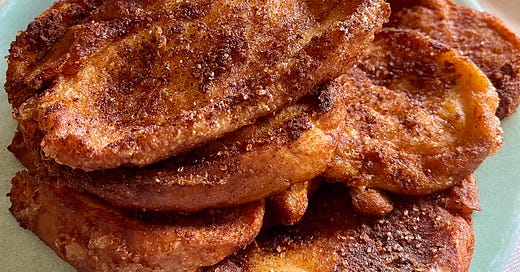🍞It's NOT French Toast!
Spain's Holy Week treat makes a delicious desayuno (breakfast) or merdienda (snack)
It's the most solemn yet vibrant time of the year in Spain—Semana Santa, or Holy Week. Amid the processionals and pageantry retelling the story of Jesus's resurrection and crucifixion, there’s a sweet that could easily be mistaken for an American breakfast favorite. Torrijas (to-REE-has) are Semana Santa’s traditional sweet—sliced bread soaked in cinnamon-infused milk and egg and fried. But, as my Spanish friends vehemently insist, "It's NOT French Toast!"
A Roman, Moorish, Catholic, and Sephardic Sweet
The diverse origins of torrijas represent Spain’s deep historical roots.
In ancient Rome, Marcus Gavius Apicius created the earliest version of what we now know as torrijas.
The Moors had their version, called zalabiyya, or fried honey fritters.
Iberian Sephardic Jews called them verandas de parida, or labor slices, believing the eggs in torrijas represented fertility and provided nourishment for pregnant and postpartum women.
Fast-forward to the 15th century, when Catholic nuns repurposed stale bread into this delightful treat. They soaked it in milk (or wine, before milk was widely available) and fried it to golden perfection, y ya está (and that’s it).
Torrijas became synonymous with Lent as a meatless alternative (but still indulgent, no?) and Easter, representing the body and blood of Christ (when made with wine).
Torrijas Today
The first time I made torrijas was during the COVID-19 pandemic. Freshly vaccinated and planning our wedding, my soon-to-be husband and I dipped and flipped the soaked bread slices, excited for the first time in months that we might have a future to look forward to beyond the four paper-thin walls of our one-bedroom apartment. I posted photos and videos to social media, describing torrijas as “Spanish French toast.”
Americans gave likes and asked for the recipe—Spaniards came at me in the comments. "Torrijas are deep-fried!" they protested, emphasizing the cardinal culinary difference. They aren’t wrong, pero tíos (but y’all); I maintain that “Spanish French toast” is the easiest way to describe torrijas to someone unfamiliar with them.
Here’s what else sets torrijas apart from French toast so you can argue with educate your friends:
Cooking fat: butter (French toast); olive oil (torrijas)
Cooking method: pan-fried (French toast); deep-fried (torrijas)
Egg & milk dipping mixture: mixed together (French toast); milk first, then egg (torrijas)
Milk: a little cinnamon powder (French toast); cinnamon stick and citrus infused (torrijas)
Cinnamon & sugar finish: none (French toast); lay it on thiiiiick (torrijas)
Serving temperature: hot (French toast); room temperature (torrijas)
Wherever you stand, it's clear that torrijas are stand-alone, proudly Spanish, and deliciously unique. Next time you're savoring a slice of egg-and-milk-soaked fried bread, remember: it's not just a treat; it's centuries of history and culture on a plate—with a side of "not French toast" sass if you’re in Spain!






Ohhhh, will have to try this recipe!